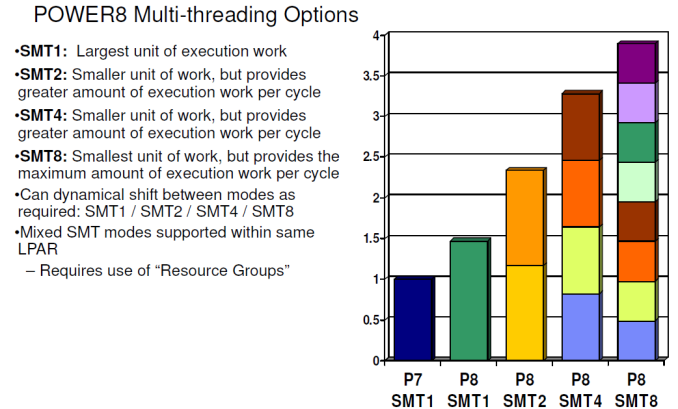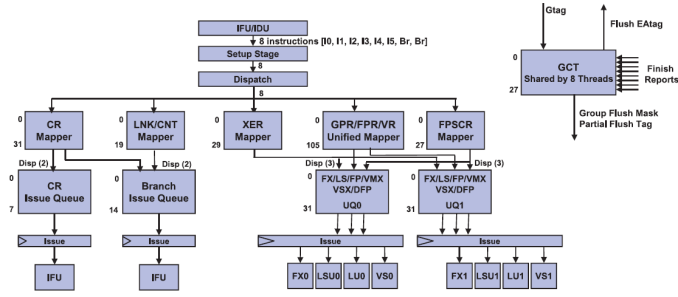Assessing IBM's POWER8, Part 1: A Low Level Look at Little Endian
by Johan De Gelas on July 21, 2016 8:45 AM ESTMulti Threading Prowess
The gains of 2-way SMT (Hyperthreading) on Intel processors are still relatively small (10-20%) in many applications. The reason is that threads have to share most of the critical resources such as L1-cache, the instruction TLB, µop cache, and instruction queue. That IBM uses 8-way SMT and still claims to get significant performance gains piqued our interest. Is this just benchmarketing at best or did they actually find a way to make 8-way SMT work?
It is interesting to note that with 2-way SMT, a single thread is still running at about 80% of its performance without SMT. IBM claims no less than a 60% performance increase due to 2-way SMT, far beyond what Intel has ever claimed (30%). This can not be simply explained by the higher amount of issue slots or decoding capabilities.
The real reason is a series of trade-offs and extra resource investments that IBM made. For example, the fetch buffer contains 64 instructions in ST mode, but twice as many entries are available in 2-way SMT mode, ensuring each thread still has a 64 instruction buffer. In SMT4 mode, the size of the fetch buffer for each thread is divided in 2 (32 instructions), and only in SMT8 mode things get a bit cramped as the buffer is divided by 4.
The design philosophy of making sure that 2 threads do not hinder each other can be found further down the pipeline. The Unified Issue Queue (UniQueue) consists of two symmetric halves (UQ0 and UQ1), each with 32 entries for instructions to be issued.
Each of these UQs can issue instructions to their own reserved Load/Store, Integer (FX), Load, and Vector units. A single thread can use both queues, but this setup is less flexible (and thus less performant) than a single issue queue. However, once you run 2 threads on top of a core (SMT-2), the back-end acts like it consists of two full-blown 5-way superscalar cores, each with their own set of physical registers. This means that one thread cannot strangle the other by using or blocking some of the resources. That is the reason why IBM can claim that two threads will perform so much better than one.
It is somewhat similar to the "shared front-end, dual-core back-end" that we have seen in Bulldozer, but with (much) more finesse. For example, the data cache is not divided. The large and fast 64 KB D-cache is available for all threads and has 4 read ports. So two threads will be able to perform two loads at the same time. Another example is that a single thread is not limited to one half, but can actually use both, something that was not possible with Bulldozer.
Dividing those ample resources in two again (SMT-4) should not pose a problem. All resources are there to run most server applications fast and one of the two threads will regularly pause when a cache miss or other stalls occur. The SMT-8 mode can sometimes be a step too far for some applications, as 4 threads are now dividing up the resources of each issue queue. There are more signs that SMT-8 is rather cramped: instruction prefetching is disabled in SMT-8 modus for bandwidth reasons. So we suspect that SMT-8 is only good for very low IPC, "throughput is everything" server applications. In most applications, SMT-8 might increase the latency of individual threads, while offering only a small increase in throughput performance. But the flexibility is enormous: the POWER8 can work with two heavy threads but can also transform itself into a lightweight thread machine gun.












124 Comments
View All Comments
DomOfSF - Thursday, July 21, 2016 - link
Johan de Gelas: blowing minds and educating "the rest of us" since...I dunno, a really long time ago (especially in internet years). Great job on the data, but the real good stuff is in your thoughts and analysis. Thank you!close - Saturday, July 23, 2016 - link
Over a decade...JohanAnandtech - Thursday, July 28, 2016 - link
13 years in the server business, 18 years now of reviewing hardware :-). Thx !!jamyryals - Thursday, July 21, 2016 - link
It seems to me, Intel's focus on bringing their CPU architecture design all the way down to 5W is the reason IBM is able to stand out against them. Intel is focused on creating a scalable architecture while IBM can throw the whole kitchen sink at the server market.Fascinating article, I really enjoyed it.
smilingcrow - Thursday, July 21, 2016 - link
Intel has plenty of unique features in their server platforms which aren't in the consumer platforms so I don't think that is the issue.jospoortvliet - Tuesday, July 26, 2016 - link
The basic design of the core still is the same so there is probably at least some truth in the statement of Jamy.Kevin G - Wednesday, July 27, 2016 - link
Up until this point. Consumer SkyLake and server SkyLake are going to be two different designs. They're certainly related but server SkyLake will have 512 KB of L2 cache per core and support AVX-512 instructions.Server SkyLake is also going to support 3D Xpoint DIMMs, though that difference is more with the platform/chipset than the actual CPU core.
floobit - Thursday, July 21, 2016 - link
Very interesting. It seems odd to me that they chose to configure it in a 2U - except for big data clusters, most of the market space I see this playing is dominated by FC to a SAN. Is this a play in the big data cluster space, or the more traditional AIX/DB2/big iron that IBM has owned for so long?Some questions I'd have:
what virtualization is possible with this architecture? presumably just the standard PowerVM? How well does that work?
What is the impact of IO latency? Could you throw a P3700 or two in here?
JohanAnandtech - Thursday, July 21, 2016 - link
2U: Besides big data storage needs, I suspect 2U is necessary for adequate cooling for the POWER8 chip.Virtualization: Linux KVM works well as far as I know.
We actually tried out a P3700 in there (see: http://www.anandtech.com/show/9567/the-power-8-rev... ) and it worked very well. I asked IBM what a customer should expect when using third party storage (probably no support, but how about waranty?) but no answer yet.
mystic-pokemon - Friday, July 22, 2016 - link
Hi Johan2U is not necessary for cooling a POWER 8 Chip. We do that better with our Barreleye (1.25 OU design). Even storage wise Barreleye has 15 Disk storage bay that can be seen in below links.
http://www.v3.co.uk/v3-uk/news/2453992/google-and-...
Let me know if you wanna ever benchmark a Barreleye. What specific POWER8 proc are you benchmarking with ? (Turismo?). I believe it does slightly better than S812LC on many benchmarks based on the variant of power8 proc S812LC runs.